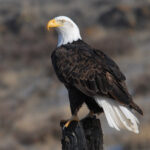The bald eagle, a majestic symbol of the United States, is known for its distinctive white head and tail, and its impressive wingspan. These magnificent birds thrive in specific habitats that provide them with the necessary resources for survival and reproduction. In this comprehensive guide, we will explore the ideal bald eagle habitat and the key factors that contribute to their success.
The Ideal Bald Eagle Habitat
Bald eagles are found primarily in North America, with a particular concentration in Alaska and along the Pacific Northwest coast. Their ideal habitat is characterized by the presence of large bodies of water, such as lakes, rivers, and coastal areas, which provide a reliable source of their primary food source: fish.
Bald eagles also require tall, mature trees or cliffs near their foraging areas to build their massive nests. These nesting sites are typically located in areas with minimal human disturbance, allowing the birds to breed and raise their young in peace.
Habitat Requirements for Bald Eagles
 Image source: Bald Eagle (Haliaeetus leucocephalus) in Kachemak Bay, Alaska
Image source: Bald Eagle (Haliaeetus leucocephalus) in Kachemak Bay, Alaska
To thrive, bald eagles have specific habitat requirements that must be met. These include:
-
Proximity to Water: Bald eagles are highly dependent on aquatic environments, as they primarily feed on fish. They prefer to nest near large bodies of water, such as lakes, rivers, reservoirs, and coastal areas, where they can easily access their prey.
-
Tall, Mature Trees or Cliffs: Bald eagles build their nests in the tops of tall, mature trees or on the ledges of cliffs. These nesting sites provide the birds with a clear view of their surroundings and protection from predators.
-
Minimal Human Disturbance: Bald eagles are sensitive to human activity and disturbance, especially during the breeding season. They require a reasonable degree of freedom from human interference to successfully raise their young.
-
Abundant Food Supply: Bald eagles are opportunistic predators, but their primary food source is fish. They need a reliable and abundant supply of fish to sustain their large size and energy requirements.
-
Suitable Perching Sites: Bald eagles often perch on tall trees, snags, or other elevated structures to survey their territory and search for prey. These perching sites are an essential component of their habitat.
Bald Eagle Nesting Habits
Bald eagles are monogamous and maintain the same breeding pair year after year. They build their nests, also known as aeries, on the tops of tall trees or on the ledges of cliffs. These nests can be quite large, measuring up to 6 feet in diameter and 6 feet in height, and can weigh over a ton.
Bald eagles typically lay two or three eggs, which are incubated for about 35 days. The parents take turns incubating the eggs and caring for the chicks, which remain in the nest for approximately 12 weeks before learning to fly and becoming independent.
Threats to Bald Eagle Habitat
Despite their recovery from near-extinction, bald eagles still face various threats to their habitat and survival. These include:
-
Habitat Loss and Fragmentation: Deforestation, urban development, and other human activities can destroy or fragment the bald eagle’s preferred nesting and foraging habitats.
-
Pollution and Contaminants: Bald eagles are susceptible to the effects of chemical pollutants, such as mercury, persistent organic chemicals, and heavy metals, which can impact their health and reproductive success.
-
Human Disturbance: Increased human activity, such as recreational activities, construction, and transportation, can disrupt bald eagles’ nesting and foraging behaviors, leading to nest abandonment or reduced breeding success.
-
Climate Change: Changing weather patterns and environmental conditions can affect the availability of the bald eagle’s primary food source, fish, as well as the suitability of their nesting sites.
To protect and conserve the bald eagle population, it is crucial to maintain and restore their ideal habitat, while also addressing the various threats they face. By understanding the specific habitat requirements of these majestic birds, we can take steps to ensure their continued success and presence in the ecosystems they call home.


